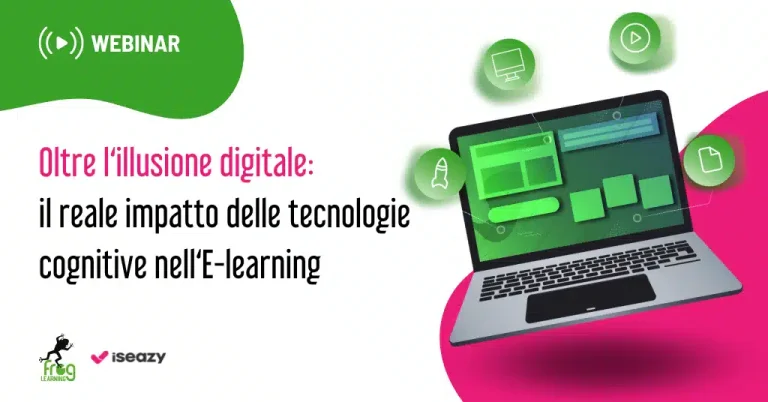Summary
Learning agility: what it is
Learning agility is the ability to learn based on experience combined with a good disposition to change, novelty and adaptability. It is about assimilating certain knowledge and learning not only to apply it, but also to use it in new and different ways depending on the context.
In a nutshell, we could say that learning agility is the ability to know how to intervene even when one does not know what to do.
Depending on the context, the concept of learning agility can be either a property of the individual or of a larger work group, an institution or a company. For example, being able to transition effectively from the routine of office work to smart working is an example of learning agility, which applies to each worker individually; whereas, the ability to operate remotely as a team-with all that that entails in terms of procedures, meetings, software, etc. – on the other hand, is a situation that transcends the individual worker and can only find its balance in the alignment of all team members as such.
In short, learning agility is a real mindset that is becoming increasingly important in the age of digital transformation.
Learning agility vs agile self learning
Speaking of “learning” and “agility,” perhaps you have heard of Agile Self-learning. The two, of course, are related.
Agile self-learning (which could be translated as “agile self-learning”) is a mode of autonomous learning in which the individual voluntarily decides to acquire new knowledge and skills, focusing on a repetition of practical aspects and making experience his or her training vector. In doing so, he breaks free from a preset path, preferring flexibility and experimentation, sometimes even in working groups.
If Agile Self-learning is an experience-based learning mode, on the other hand, learning agility is the mindset and propensity of the user to activate and make the best of this approach.
There is, in fact, a fundamental aspect that emerges from what has been said so far. Experience alone is not enough, and this is where the core value of learning agility comes in: the ability to draw on experience already gained and reshape it according to job requirements.
Having learning agility: what does it mean?
The cornerstones on which learning agility rests are the readiness to change, innovate and apply what is learned in a different context: flexibility is what drives this process. For this mindset to be entirely effective, however, it is important that the new acquisition of knowledge and its redeployment occur smoothly, quickly, and without hiccups.
But what are the elements that allow us to say that a person has learning agility?
- He is not afraid of change, unexpected situations, new contexts, and problems. In fact, he experiences anything new as a stimulus.
- Always look for all possible avenues. Error and failure are also formative steps;
- Actively seek to learn new things.
If we wanted to go for a wow factor and choose an impactful label, we could say that a person with learning agility is a learning daredevil.
High learning agility vs. low learning agility
One of the most interesting and useful projects for our further study is the one carried out by researcher Carol Dweck, who conducted a study
[1]
On the application of learning agility. Taking adults and children into consideration, the researcher started with a simple question: why do some individuals excel at challenges while others falter?
The answer-which seems simple-is to be found in the different ability to be open to learning, which often reflects the different inclination to embrace change and be able to adapt to it. This openness varies with the individual, because learning agility is not an “on/off” mindset, but rather a spectrum of different nuances ranging from high learning agility to none.
[1] Dweck, Carol, Mindset: The New Psychology of Success. New York: Random House, 2006.

What does it mean to have high learning agility?
Wanting to give a definition, those with high learning agility enter into a logic of continuous learning, necessary to adapt to the uncertainties that the market presents.
Learning agility is an attitude to be cultivated, a real skill to be developed.
The corporate world, which is invested by its nature with multiple transformations, does not look for a spontaneous propensity for change in people, but rather aims to have everyone develop the ability to be open to learning through action.
In this regard, one of the most effective tools is definitely feedback. When people are measured by activities other than what they normally deal with, they do not have many benchmarks to give objective and reliable assessments of their own performance. This is where another person’s feedback becomes indispensable in order to retrace one’s actions with a critical eye and in a logic of continuous improvement.
The presence of feedback thus makes it possible to operate and make decisions in a dynamic and partly unfamiliar environment-as business often is-without the fear of failure.
Agility is, in fact, the ability to adapt to uncertainty. This requires an openness to learning based on a growth mindset whereby our individual and organizational capabilities are not fixed, but can be continually developed.
What does it mean to have low learning agility?
One of the most characteristic elements of learning agility is, as we have seen, the ability to experiment and measure oneself against new challenges. Thus, if we were to describe the individual with low learning agility, we could say that he or she is the one who is unwilling to confront new situations.
Having low learning agility means, in fact, not being fully inclined to work on one’s ability to put oneself out there, even exposing oneself to the risk of failure. It may happen that in an organization part of the employees work hard, but only within the perimeter of their own activities, never raising their heads and allowing themselves a glimpse of possible new challenges. These people, to understand it better, are more likely to ask “how can I employ my skills in this situation?” rather than “how can I develop the skills the organization needs at this time?”
The difference is glaring.

The dimensions of learning agility
Carol Dweck’s study is but a starting point. Once the extremes of a hypothetical ladder of learning agility have been defined, the question arises-as it often does-who stands at the top.
Studies carried out on the subject by Korn Ferry International–famous American business consulting firm–highlight how learning agility is a rather reliable index of leadership skills. This is because the higher you go upward in the organizational chart, the more frequently you are exposed to the unexpected, uncertainty and change. And, as the operational comfort zone widens, the ability to invest and reinvest information, skills and procedures acquired in contexts not necessarily related becomes of great value.
We speak, in this regard, of
learning agile leaders
, referring precisely to those who can easily adapt to these situations.
To parameterize the capabilities of leaders (and others), Korn Ferry has identified and defined five key dimensions of learning agility:
- Mental agility, that is, solid critical thinking that can adapt quickly to situations and evaluate them accurately;
- Relational agility, that is, the ability to understand other people, relate to them, and be able to manage each situation to maximize the collective effort;
- Adaptive agility (or resilience), that is, being able to make the best of any situation-even the worst ones-and use them to progress, learn, and advance;
- Agility in results, that is, possessing a certain vision that can facilitate finding the best solution through the reuse of experience accumulated in the past;
- Self-awareness, or awareness of oneself, one’s abilities, resources and how best to put them to use.
These five dimensions are, in fact, the five pillars of learning agility, and refining them will speed up the time it takes to learn and apply the information learned.
The importance of learning agility in the world of work (digital and otherwise)
Learning agility is a most important growth tool for companies because it allows resources to try their hand at new ventures in a continuous learning stream where change is the only acceptable constant. Today’s job market requires constant redefinition of one’s skills, to the point that it is increasingly common to feel that one has strayed very far from one’s professional starting point.
Having people on one’s team who are willing to develop an aptitude for learning agility comes close to every organization’s dream of being able to accomplish internally what they need to do, drawing on the skills of people who were previously doing something else entirely. This “continuous retraining” of teams provides greater control over work processes in line with corporate values; it also enables individuals and groups to harmonize their work with that of others, reducing contingencies and ensuring smoother operational processes.
In this logic, embracing learning agility for an organization means, above all, being competitive in the world of work, especially in an era of incessant change such as the one we are currently experiencing.

Developing and fostering learning agility in companies
A culture open to learning agility starts with the manager setting an example for his or her team. In this case, leading by example does not correspond to the practice of sharing the effects of effective behavior, but rather to the ability to expose oneself to the risk of failure. Managers must know how to teach their teams the attitude of pushing their own limits in order to understand change and derive opportunities from its effects.
Planning a cycle of training interventions aimed at experiencing the importance of feedback for the growth of the organization within a complex and ever-changing system may be a viable avenue, for example.
Organizing team-building events that encourage people to be open to the opportunity of putting themselves on the line-or questioning their professional certainties-can be an interesting development.
The areas of focus for the development of learning agility are many: interpersonal skills, problem solving, ability to handle the unexpected.
You will go nowhere unless a new way of thinking, a new cultural arrangement centered on interpreting change as an opportunity, spreads and consolidates first.
The shortcut to agility
We have seen how upstream of learning agility is the ability to challenge oneself and, most importantly, to question one’s modus operandi.
All initiatives aimed at enhancing the predisposition to move beyond one’s comfort zone, that is, to abandon habits, modes of operation that make us feel protected and secure because they are frequently experienced, can be useful in this regard.
In this dynamic, the winning approach is one that is proactive and characterized by a willingness to go along with new stimuli…even if they may initially appear frightening.
Curiosity to learn and discover is the ingredient behind this approach, which focuses on finding new solutions, applying problem solving, and developing new strategies.
In this regard, two important starting points should be kept in mind:
- Learning is the result of experiences;
- Learning is nurtured by relationships with others, whether they are co-workers or superiors. Their feedback becomes a key tool for skill development and improvement.
In summary, then, the value of testing oneself in a new situation, recalling the fruits of past experience, is to be able to develop new skills that are increasingly specific and refined. Skills that will complement those already present and can be used and repurposed in the future.
Future challenges
We are increasingly talking about spontaneous learning but also about lifelong learning, social learning (in its version enhanced by the digital revolution), and we are doing so in a system-the corporate system-that recognizes and incentivizes learning in all its forms.
And this, on closer inspection, gives us a cross-section of a situation that was probably unthinkable a few years ago.
The challenge from here on may be to identify, enhance and guide the learning agility of individuals so as not to waste a single drop of that potential. And if a structured pathway may seem like something too complex (in terms of variety of topics, skills, depth, etc.) perhaps it is just a matter of abandoning an outdated structure, such as that of a linear pathway, and embracing new architectures made up of networks, layers and interconnections.








